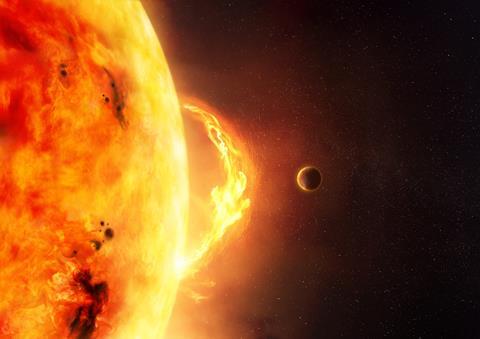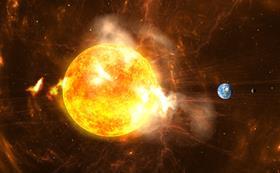’Without proper modelling of such complex interconnected risks, the impacts are largely unknown,’ says senior meteorologist.

’Imagine waking up tomorrow to a seemingly post-apocalyptic world – business has come to a halt, the power grids are down and no one can find a working radio or access the internet.
That would be just some of the results of a long-lasting radiation storm, created by a x-class solar flare directed at the planet.
However, Andrew Siffert, senior vice president and senior meteorologist at specialist insurance and reinsurance broker BMS Group, told GR’s sister title Insurance Times that “solar flares are a classic gray swan event for the insurance industry”.
He said that as the sun is expected to reach the peak of its cycle in the summer of 2025, underwriting processes may not be taking into account the risk of potential exposure to solar flare risks ”because there is no model and there is minimal loss experience”.
Siffert explained that the industry needed to better understand these types of risks, considering that the occurrence of a solar flare storm was “just as plausible in a lifetime as the main industry topics like climate change”.
“One can only imagine what would happen if large parts of some countries were without power for months,” he added.
“Some might say solar flares are even worse than issues like climate change because there is no way to completely eliminate the risks of solar flare storms.”
’Tremendous explosion’
According to the European Space Agency (ESA), a solar flare is a “tremendous explosion on the sun that happens when energy stored in twisted magnetic fields – usually above sunspots – is suddenly released”.
There are three categories in which the ESA classifies solar flares according to their brightness in the x-ray wavelengths – this includes the largest x-class flares, medium-sized m-class flares and smaller c-class flares, which the ESA said “cause few noticeable consequences here on earth”.
“The category that should cause the worry would be x-class flares,” said Siffert.
NASA stated that the amount of solar flares would increase around every 11 years – forming a solar maximum. The last solar maximum occurred between 2012 and 2014.
In the “most extreme and rarer events”, RSA’s head of underwriting strategy Michael Gregory said that significant risks could occur.
He said these included a national blackout, loss or disruption to services reliant on satellite-enabled technologies, damage to trans-oceanic communication cables, possible damage or total failure of satellites, disruption of global navigation satellite systems (GNSS) positioning – impacting ships and aircraft – and mobile communication networks.
Gregory also added that essential services could be disrupted – including transport, retail, finance, energy and communications.
Coronal mass ejection
Gregory further noted that a solar flare event could see radiation increase high in the atmosphere, which could affect aircraft passengers and crew.
In December 2006, NASA stated x-class flares caused a coronal mass ejection (CME), which interfered with GPS signals being sent to ground-based receivers.
And three years earlier in October and November, the most intense solar flare on record – dubbed the Halloween Storms of 2003 – impacted the aviation industry in both the UK and the US.
In the UK, for instance, the Parliamentary Office of Science and Technology reported in July 2010 that the compass north changed temporarily by five degrees in six minutes.
One Japanese satellite costing $640m, furthermore, was permanently damaged.
The Quebec Blackout Storm in March 1989 also saw residents in Canada experience an electrical blackout for nine hours and transport links were shutdown.
Speaking about the potential implications for the insurance industry of a CME, a spokesperson for insurance analytics company for Verisk said: “Depending on the potential magnitude of this hypothetical event, a large number of people could be without power for up to several months.
“Many vehicles would likely be damaged, presenting a large exposure for auto insurers.
”Property also would likely be damaged and millions of businesses might be forced to shut down, resulting in massive impacts for property insurers as well.”
Addressing underwriting
Considering underwriting, Siffert said that although the insurance industry knew that solar flare storms could occur and that it would result in impacts, without “proper modelling of such complex interconnected risks, the impacts are largely unknown”.

Recent interconnected events that the insurance industry was arguably unprepared for and suffered significant losses as a result of include the Covid-19 pandemic and the 2011 Tōhoku earthquake and tsunami.
Siffert highlighted that “insurers may face increased claims related to power outages, equipment failures and damage to insured assets” due to solar flares.
However, he noted that “assessing the extent of damage and determining the loss to property and infrastructure is complex” and the lack of models left firms with little understanding over how these might affect business interruption (BI) in particular, despite “specific limits [existing] to evaluate and quantify BI losses”.
The ABI states that BI insurance covered a business for loss of income during periods when they cannot carry out business as usual due to damage caused by a specific set of risks that will be specified in the policy.
Gregory said that under a “severe scenario”, the insurance industry could expect property losses from direct damage to transformers and electrical equipment, as well as perishable freezer contents.
In addition to BI claims from companies directly impacted, he said contingent BI from disrupted supply chains, pollution and environmental liability, as a result of loss of power and claims against directors, could arise if ”companies were viewed as not having taken enough preventative action to secure continuity”.
Siffert added that a storm could also trigger data recovery, restoration and potential liability claims in cyber policies.
“It’s also important to note, however, that these risks are not necessarily interlinked,” said Gregory.
“While several of these could occur concurrently under an extreme scenario, the events in 1989 and 2003 highlighted that impacts can be relatively isolated when storms are of a lower magnitude.”
More widely, Siffert said that “insurers may have exclusions or limited coverage for damages caused by solar flares or geomagnetic storms”, which “could create a protection gap and put a burden on society”.
And, considering (re)insurance and the large unknown around potential losses and the risks, he questioned what a solar flare incident would do to resinsurance coverage availability and pricing.
Call to action
Despite the unknowns in the insurance sector, Siffert acknowledged that it was “not all doom and gloom”.
He said that in general, there had been “significant steps taken to mitigate the risk from solar storms” – such as “better detection of the events and the gardening of known possible failure points like better electrical grid monitoring”.
He also felt there was a “real opportunity” was for insurance firms to “take a different look at risk”, as well as collaborating with scientists and engineers to “help protect our society” from the potential impacts.
“If the insurance industry better understands the impacts and threats, it can help society address these challenges,” he said.
“This would also allow the industry to develop specialised coverage solutions and improve disaster response strategies related to solar flares and their potential impacts.”
Gregory added that “like any risk on the radar, opportunities are as much about education and furthering knowledge as they are about mitigation”.
“In the short-term, the insurance industry has a key role to play in alerting clients to the risks that solar flares present to their operations, supporting them in mitigating these risks and ultimately providing coverage and risk transfer solutions,” he said.
“Brokers, [in particular], have a critical role they play in informing and educating customers, given they have the opportunity to get ahead of emerging risks such as solar flares, providing their clients with appropriate support in ensuring that their businesses, operations and people are protected.”
This article originally appeared on GR’s sister publication, Insurance Times, here.










No comments yet